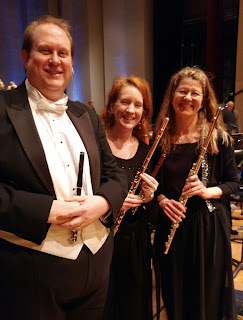 |
| The Flint Symphony Orchestra flute section: L-R Scott Graddy, Alice Lenaghan, Laura Larson |
At the Flint concert, after everyone but the final two
violinists left the stage and gathered in the wings, Paul was brought up to the
front of the stage. One by one, we each gave him a flower and a hug or words of
appreciation for his many years of service to the orchestra, then sat in our
chairs as the final presentations and speeches were made.
After intermission we joined forces with soloists, the Flint
Festival Chorus and the Ann Arbor Youth Chorale to perform a fitting conclusion to the season – Carmina Burana by Carl Orff. In 1935 Orff came across the
collection of dozens of secular songs from the Thirteenth Century which had
been discovered in 1803 at the old monastery of Benediktbeuren in Upper Bavaria
and published in 1847. He organized selected poems into three sections –
‘Springtime’, ‘In the Tavern’ and ‘The Court of Love’ - with a prologue and
epilogue as a “scenic cantata” for choirs, soloists, orchestra and “magical
tableaux” (mime and dance). When I say secular, I mean not suitable for family
entertainment. To give you an example, our fearless leader, maestro Enrique
Diemecke decided it would be fun to have the orchestra sing along on the
penultimate chorus, “Oh, oh, oh, I am bursting out all over! I am burning with
first love!” (English translation from the Latin) and that’s the part with the
G rating! Carmina Burana is fun to play and the audience certainly loved it. If
you’ve never heard it, go listen to it right now! Actually, if you watch
television I’m sure you have heard part of it anyway. Does “O Fortuna” sound
familiar?
Flint is a special place. Who would expect the city that has
endured hardship after hardship to have a thriving symphony orchestra? All we
hear about Flint now is the water crisis. The whole world knows about Flint’s
water crisis and how it has tainted the image of a city that was already badly
damaged (think of Michael Moore’s film, Roger
and Me, struggling schools, and emergency management, to name a few
problems in recent memory). But what about the jewels of the city – the
cultural institutions?
The Flint Symphony Orchestra has endured for 99 years in its
little corner of the cultural center. Yes, we have suffered crises, too. After
the recession of 2008 the parent organization of the Flint Symphony, the Flint
Institute of Music (FIM), suffered a loss of funding and had to ask us for
concessions. We took a huge pay cut, as did many workers at the time, and it
took years to climb out of it. When your wages are drastically cut it can
influence your self-esteem. I think Paul Torre understood this and frequently
came to the rehearsals to voice his gratitude for our sacrifice and for our
musical gift to the community. That
didn’t cost him anything. It certainly built up his reputation with the
musicians. After the conclusion of one season as FIM was climbing out of the
financial hole, every musician who had played that season received a bonus check
with a heart-felt letter of appreciation from Paul Torre.
Yes, Flint is a special place and the 99th season
of the FSO is a special time. I could feel the energy and enthusiasm propelling
us toward the landmark 100th season next year. We’ll be venturing
forth without Paul Torre at the helm but our conductor of over 20 years,
Enrique Diemecke, will lead us into our next century of inspired music-making.
Maestro Diemecke (we all call him Enrique) is the guiding force which gives our
orchestra its identity in the community. We are fortunate in Flint to have such
a charismatic leader on the podium. You will have to wait for more about
Enrique – he deserves a blog post of his own.
 |
| Yours Truly in the lobby at the FIM |

Thank you, Laura, for taking time to recognize the hard-working musicians of the Flint Symphony Orchestra, the Flint Festival Chorus and the dedicated personnel of the Flint Institute of Music. The season finale was beyond fantastic, and I can't wait to see what the future of these amazing organizations brings! - Scott Graddy
ReplyDeleteThanks for your reply on my blog, Scott!
Delete